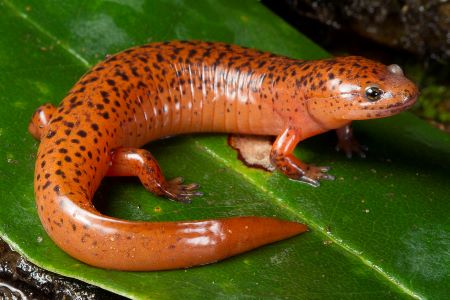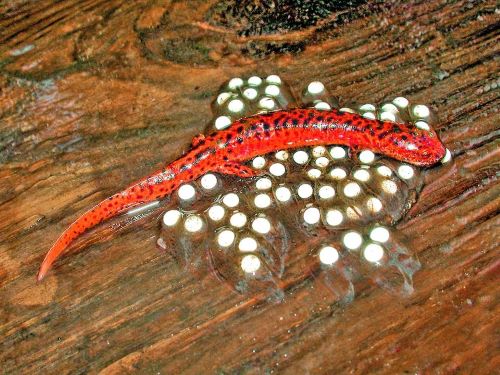Red Salamander: Difference between revisions
Updated intro and got most references established |
Creating Red Salamander Page MK. II |
||
| Line 34: | Line 34: | ||
== Ecology == | == Ecology == | ||
Red Salamanders are | Red Salamanders are found in colder springs, seepages, and springs in forested riparian corridors, but can also live away from aquatic environments in more woody environments. <ref name="Indiana">Red Salamander (Pseudotriton ruber)—Indiana Herp Atlas. (n.d.). Retrieved April 30, 2025, from https://www.inherpatlas.org/species/pseudotriton_ruber</ref>. Some terrestrial habitats include under rocks, logs, or [[moss]] within woodland ravines or open fields <ref name="Wildlife Resources Agency"></ref>. The Red Salamander resides between altitudes of sea level and 1500 meters. The most common habitat for these amphibians is within deeper springs because of the more consistent temperature throughout the year, especially in colder months. When it gets warmer such as spring and summer, we can see the salamanders begin to emerge from these water bodies and take on the more terrestrial habitats previously discussed <ref name="ADW"></ref>. The scope of their habitat is quite wide, found mostly with the Eastern United States. They are found as far north as New York within the Hudson River all the way to the coast of the Gulf of Mexico in Louisiana, and everything in between <ref name="Monaco">Mazza, G. (2011, January 28). Pseudotriton ruber. Monaco Nature Encyclopedia. https://www.monaconatureencyclopedia.com/pseudotriton-ruber/?lang=en</ref>. | ||
</br></br> | |||
[[File:Red Salamander Eggs.jpg|501px|left|thumb|Red Salamander Laying Eggs <ref name="Monaco"></ref>]] | |||
== Reproduction and Life Cycle == | |||
Mating season for the Red Salamander occurs annually, usually in the summer, but can vary depending on the geographic location <ref name="AmphibiaWeb"></ref><ref name="Indiana"></ref>. Courtship, which is the behaviors that [[animals]] use to attract a potential mate, can happen with multiple partners for both the male and female sexes <ref name = "ADW"></ref>. It is initiated by the male and the courtship contains some head rubbing between the salamanders and a tail-straddling walk. The male secretes a spermatophore for the female that can be later used for fertilization (max production of 2 per night), but the female must pick up the sperm packet so the male must continue to perform a dance and gesture towards the packet. If and after the female collects the packet, the two separate slowly after <ref name="AmphibiaWeb"></ref><ref name="ADW"></ref>. | |||
<br></br> | <br></br> | ||
After pickup, the female is able to store the spermatophore for quite a long time until she believes that the conditions are right for laying her eggs. Eggs are laid in the fall and early winter and the amount of eggs laid can range between 29-130 eggs, averaging 80 per batch <ref name="Monaco"></ref>. | |||
== Diet and Feeding Behaviors == | == Diet and Feeding Behaviors == | ||
== Defense Mechanisms == | |||
== | |||
== References == | == References == | ||
Revision as of 14:48, 30 April 2025
 | |
| Kingdom: | Animalia |
|---|---|
| Phylum: | Craniata |
| Subphylum: | Vertebrata |
| Superclass: | Gnathostomata |
| Class: | Amphibia |
| Subclass: | Lissamphibia |
| Order: | Caudata |
| Family: | Plethodontidae |
| Genus: | Pseudotriton |
Psuedotriton ruber, more commonly known as the Red Salamander, are larger amphibians belonging to the Plethodontidae family. In latin, ruber means "red" and in greek psuedotriton means "false god" in reference to Triton, the son of Posidon. Others say that this could also mean "false newt" [4] [5]. These are amphibians who have a redish orangish skin pigmentation with black spots along the back and chin, a yellow iris, and a rather shorter tail. [6]. The size of Red Salamanders can very between 11 to 18 cm, or 4.33 to 7.09 in, with females tending to be slightly larger and all contain 16 grooves along their body. As they age, it has been shown that adults tend to turn a purplish brown, loosing their vibrant colors over time [7]. There are 4 infraspecies within this species (Pseudotriton ruber nitidus, Pseudotriton ruber ruber, Pseudotriton ruber schencki, and Pseudotriton ruber vioscai), and they often get mistaken for Mud Salamanders. Their yellow iris is what separates them from the Mud Salamander species, who has a brown iris [1].
Ecology
Red Salamanders are found in colder springs, seepages, and springs in forested riparian corridors, but can also live away from aquatic environments in more woody environments. [8]. Some terrestrial habitats include under rocks, logs, or moss within woodland ravines or open fields [7]. The Red Salamander resides between altitudes of sea level and 1500 meters. The most common habitat for these amphibians is within deeper springs because of the more consistent temperature throughout the year, especially in colder months. When it gets warmer such as spring and summer, we can see the salamanders begin to emerge from these water bodies and take on the more terrestrial habitats previously discussed [2]. The scope of their habitat is quite wide, found mostly with the Eastern United States. They are found as far north as New York within the Hudson River all the way to the coast of the Gulf of Mexico in Louisiana, and everything in between [9].

Reproduction and Life Cycle
Mating season for the Red Salamander occurs annually, usually in the summer, but can vary depending on the geographic location [4][8]. Courtship, which is the behaviors that animals use to attract a potential mate, can happen with multiple partners for both the male and female sexes [2]. It is initiated by the male and the courtship contains some head rubbing between the salamanders and a tail-straddling walk. The male secretes a spermatophore for the female that can be later used for fertilization (max production of 2 per night), but the female must pick up the sperm packet so the male must continue to perform a dance and gesture towards the packet. If and after the female collects the packet, the two separate slowly after [4][2].
After pickup, the female is able to store the spermatophore for quite a long time until she believes that the conditions are right for laying her eggs. Eggs are laid in the fall and early winter and the amount of eggs laid can range between 29-130 eggs, averaging 80 per batch [9].
Diet and Feeding Behaviors
Defense Mechanisms
References
- ↑ Jump up to: 1.0 1.1 Pseudotriton ruber | NatureServe Explorer. (n.d.). Retrieved April 30, 2025, from https://explorer.natureserve.org/Taxon/ELEMENT_GLOBAL.2.101775/Pseudotriton_ruber
- ↑ Jump up to: 2.0 2.1 2.2 2.3 Miller, R. (n.d.). Pseudotriton ruber (Red Salamander). Animal Diversity Web. Retrieved April 30, 2025, from https://animaldiversity.org/accounts/Pseudotriton_ruber/
- ↑ Todd Pierson. Red Salamander. (n.d.). Retrieved April 30, 2025, from https://herpsofnc.org/red-salamander/
- ↑ Jump up to: 4.0 4.1 4.2 AmphibiaWeb—Pseudotriton ruber. (n.d.). Retrieved April 30, 2025, from https://amphibiaweb.org/species/4198
- ↑ Virginia Herpetological Society. (n.d.). Retrieved April 30, 2025, from http://www.virginiaherpetologicalsociety.com
- ↑ Red Salamander. (n.d.). Retrieved April 30, 2025, from https://dwr.virginia.gov/wildlife/information/northern-red-salamander/
- ↑ Jump up to: 7.0 7.1 Red Salamander | State of Tennessee, Wildlife Resources Agency. (n.d.). Retrieved April 30, 2025, from https://www.tn.gov/twra/wildlife/amphibians/salamanders/red-salamander.html
- ↑ Jump up to: 8.0 8.1 Red Salamander (Pseudotriton ruber)—Indiana Herp Atlas. (n.d.). Retrieved April 30, 2025, from https://www.inherpatlas.org/species/pseudotriton_ruber
- ↑ Jump up to: 9.0 9.1 9.2 Mazza, G. (2011, January 28). Pseudotriton ruber. Monaco Nature Encyclopedia. https://www.monaconatureencyclopedia.com/pseudotriton-ruber/?lang=en